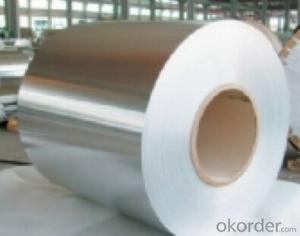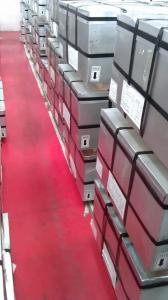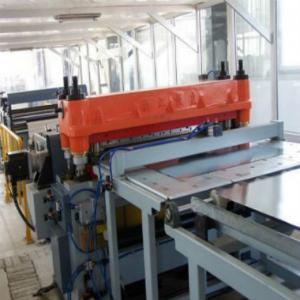Tin Free Steel for Chemical Can Use in Metal Packaging
- Loading Port:
- China main port
- Payment Terms:
- TT OR LC
- Min Order Qty:
- 25 m.t.
- Supply Capability:
- 30000 m.t./month
OKorder Service Pledge
OKorder Financial Service
You Might Also Like
1. Products: Tin Free Steel
Tinplate and TFS are widely used for making all types of containers such as artistic cans, tea cans, painting cans, chemical package cans and metal printing etc. Its applications are not limited to containers; recently, they have also been used for making electrical machinery parts and many other products.
2. Specification:
Our goods enjoyed high quality both at home and abroad. We can supply tin free steel as follows:
Technical standard | JISG3315 and GB/T24180 - 2009 (BS EN 10202:1990) |
Steel Type | MR / SPCC |
Thickness | From 0.15mm to 0.50mm (Tolerance +/- 0.01mm) |
Width | Normally 600-1050mm (Tolerance +3/-0 mm) |
Coating | Total chromium min 30mg/m2 max 140mg/m2 |
Temper & Annealing | T1-T5, DR7-8, TS230-TH435, T49-T65(+/- 4) |
Surface Treatment | Bright & Fine Stone & Stone & Silver & Matt |
Payment terms | Letter of Credit (L/C), Telegraphic transfer (T/T) |
Price terms | CFR & CIF price term |
Delivery time | Within 60 days after received L/C or T/T down payment |
Packing | High quality shipping packing which contains thin plastic film, rust-proof paper, metal cover, metal angles and strap sand pallet. |
Minimum order Quantity(MOQ) | 25 metric tons (1X 20'' container) |
3. Pictures:


4. Features of the factory price/ tin free steel/tinplate/tfs/tmbp/etp/spte:
Beautiful Appearance
Excellent Paintability & Printability
Excellent Formability & Strength
Excellent Corrosion Resistance
Excellent Solderability & Weldability
5. FAQ:
We are one of the main producers in China for tinplate, tin free steel and also TMBP. At present, our productivity is more than 450000 MT/year.
For more information about our products or company, pls contact us freely.
Welcome your enquiries and orders.
- Q: How does tinplate compare to stainless steel in terms of properties and applications?
- Tinplate and stainless steel have different properties and applications. Tinplate is a steel coated with a thin layer of tin, providing corrosion resistance and a shiny appearance. It is commonly used for packaging food and beverages, as it is lightweight and easily formed into cans. On the other hand, stainless steel is an alloy with high corrosion resistance and strength. It is widely used in various industries, including construction, automotive, and kitchen appliances, due to its durability and aesthetic appeal. While both materials offer corrosion resistance, stainless steel is generally stronger and more versatile, making it suitable for a wider range of applications compared to tinplate.
- Q: Who knows the process of tinplate production?
- Cold rolling: the hot rolled strip passes through the pickling process and enters the cold rolling process. The strip is plastically deformed during the work roll, and the thickness is about 2mm.2mm from about 0. In cold rolling, in order to reduce the friction between the strip and the work roll and take away a large amount of heat produced by the plastic deformation, the cold rolling lubricant and coolant should be sprayed onto the strip. A reversible mill with single stand is adopted. In order to keep the shape of the roller effectively, the temperature control of the cooling liquid is more important. Range of production: 0.14mm-0.5mm.Slitting: the required width of slitting material after cold rolling. Range of production: 265mm-835mmSkim: in the cold rolling process in rolling oil cooling after tin plate surface adhesion of oil and other foreign matter, such as do not wash directly by annealing the oil incomplete combustion of carbonaceous residue will stain in the strip, for the production of tinplate can meet the quality requirements. Therefore, the tin plate must be cleaned by electrolysis before removing the grease. The common method of cleaning tin plate is to degrease and degrease the degreasing liquid.
- Q: What are the main applications of tinplate in the agricultural industry?
- Tinplate is commonly used in the agricultural industry for various applications such as packaging for seeds, fertilizers, and pesticides. It provides a durable, corrosion-resistant, and tamper-proof solution that helps protect these products from external elements. Additionally, tinplate is also utilized for manufacturing agricultural equipment, containers, and storage tanks due to its strength and resistance to rust.
- Q: What are the characteristics of different tin process
- Good mechanical properties: tinplate cans relative to other containers, such as plastic, glass, paper containers and strength, and good rigidity, it is not easy to break. It is not only used for small sale packing, but also the main container for large transportation package. 2.: excellent barrier tin barrier properties than any other materials are excellent, gas barrier properties, moisture resistance, shading and aroma were good, and the sealing is reliable, reliable protection products.
- Q: What are the main applications of tinplate in the paint industry?
- Tinplate is commonly used in the paint industry for the production of paint cans or containers. Its corrosion-resistant properties make it a suitable material for storing paint, ensuring that the paint remains fresh and uncontaminated. Additionally, tinplate cans are easy to seal, preventing any leakage or spillage of paint. Overall, the main application of tinplate in the paint industry is for the manufacturing of durable and reliable paint containers.
- Q: How is tinplate recycled and what are its recycling rates?
- Tinplate, which is commonly used for food and beverage packaging, is recycled through a process called steel recycling. The recycling of tinplate involves collecting and separating it from other waste materials, followed by shredding, melting, and refining to produce new steel products. Tinplate has a high recycling rate, with approximately 80-90% of tinplate packaging being recycled globally. This high recycling rate is due to the fact that tinplate is a valuable material that can be easily and efficiently recycled, reducing the need for raw materials and minimizing environmental impact.
- Q: Can tinplate be used for industrial or automotive applications?
- Yes, tinplate can be used for industrial or automotive applications. Tinplate is a commonly used material in industries and automotive manufacturing due to its durability, corrosion resistance, and ability to withstand high temperatures. It is often utilized for making cans, containers, electrical components, automotive parts, and various other industrial applications.
- Q: What are the main challenges in tinplate supply chain management?
- The main challenges in tinplate supply chain management include the volatility of raw material prices, ensuring consistent quality of tinplate products, managing global supply and demand fluctuations, optimizing transportation and logistics, and maintaining effective communication and collaboration among various stakeholders in the supply chain.
- Q: How does tinplate packaging contribute to product aesthetics?
- Tinplate packaging contributes to product aesthetics by providing a visually appealing and attractive presentation. The shiny and smooth surface of tinplate enhances the overall look of the packaging, giving it a premium and high-quality feel. Additionally, tinplate allows for intricate designs, embossing, and printing techniques, allowing brands to create eye-catching graphics and logos that further enhance the visual appeal of the product.
- Q: What are the main applications of tinplate in the household goods industry?
- Tinplate is widely used in the household goods industry for various applications. Some of the main uses include the production of food cans, beverage containers, aerosol cans, and other packaging materials. Tinplate ensures product safety, maintains freshness, and provides protection against corrosion and light. Additionally, tinplate is utilized in the manufacturing of kitchen utensils, cookware, and decorative items due to its durability, malleability, and aesthetic appeal.
Send your message to us
Tin Free Steel for Chemical Can Use in Metal Packaging
- Loading Port:
- China main port
- Payment Terms:
- TT OR LC
- Min Order Qty:
- 25 m.t.
- Supply Capability:
- 30000 m.t./month
OKorder Service Pledge
OKorder Financial Service
Similar products
Hot products
Hot Searches
Related keywords




























